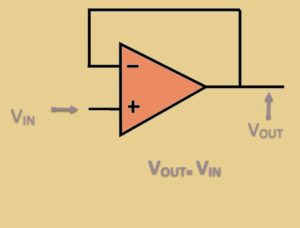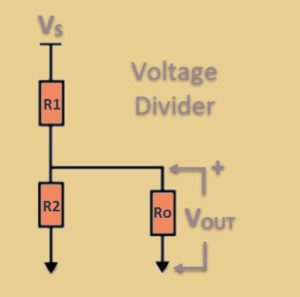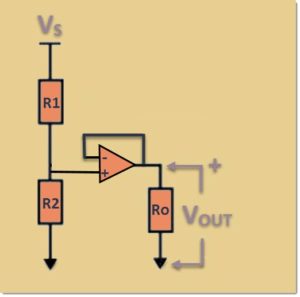A voltage follower is also known as a unity gain amplifier, a voltage buffer, or an isolation amplifier. In a voltage follower circuit, the output voltage is equal to the input voltage; thus, it has a gain of one (unity) and does not amplify the incoming signal. The voltage follower does not need any external components. See Figure 1. But if it’s an amplifier and doesn’t amplify, what’s the purpose of a voltage follower?

Operational amplifiers have a very high input impedance, which means that they don’t suck in much current (ideally, none) at the inputs. Op amps also have a very low output impedance. One application where this is useful is in a voltage divider. In a voltage divider (as in Figure 2), it’s possible that the impedance load (Ro) can vary quite a bit. Due to Ohm’s Law (V=IR), if Ro varies, it will affect VOUT.

In Figure 2, if Ro varies, then VOUT would vary accordingly unless…. you were able to isolate the voltage divider’s VOUT by inserting a high impedance voltage follower between it and Ro, as in Figure 3. Adding a voltage follower to the voltage divider circuit isolates the load impedance (Ro) so that VOUT is dependent upon R1 and R2 (see figure 3), not Ro.

This is only possible because the op amp has such a high input impedance and a low output impedance; the op amp works to maintain this state! (Remember that an op amp is a powered device, not a passive device. Op amp symbols rarely show the supply voltage to an op amp, but it’s always there when you actually hook one up.)
The voltage follower (Figure 1) allows us to move from one circuit to another and maintain the voltage level. It preserves the voltage source signal. This is why it’s also called a buffer or isolation amplifier. You can use a voltage divider circuit to switch from one logic level (e.g. 5V) to another logic level (e.g., 3.3V). A cleaner switch is obtained when a voltage follower (buffer amplifier) is added to the voltage divider circuit (Figure 3). Another way to accomplish logic level shifting or translation is to use an IC called a level shifter to accomplish the same buffered transition. The high impedance of the op amp makes it possible for the voltage follower circuit to keep the load (Ro) from affecting the output voltage.
(Logic levels are used for binary signaling (HI/LOW), not for supplying power, so use a voltage regulator if you need to step down Power (P=VI) to a load. A voltage divider is not a regulator and you could end up smoking a resistor if a voltage divider is used to step-down a power source.)
With or without a voltage divider circuit, the voltage follower, or voltage buffer, offers a means to transfer a voltage source signal from one impedance level to another without affecting current. Ohm’s Law (V=IR) dictates the relationship from there. Voltage followers are used to match impedance in other circuits, too. Note that there is also a current buffer, which preserves the current signal source, rather than voltage signal source.
